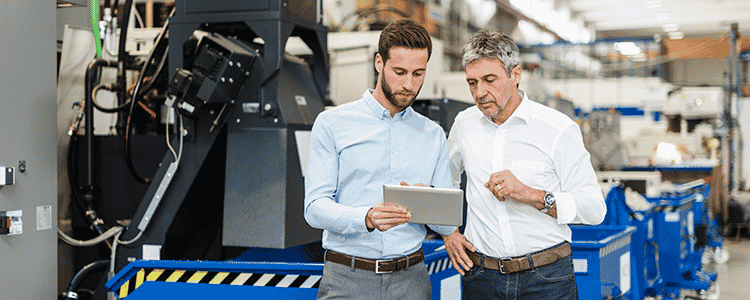The manufacturing realm has experienced more than its fair share of setbacks over the past few years. These setbacks range from skilled labor shortages and supply chain instabilities to challenges with inventory management and customer demand.
To stay afloat and remain competitive, many business leaders have adapted their best practices and adopted new strategies. They’ve also invested in tools and technologies designed to optimize operations across their enterprise.
These innovative new approaches are helping manufacturers regain their footing, even amid ongoing industry obstacles.
Today, we’re looking at some of the top manufacturing industry challenges that exist today and explaining how modern enterprise technology can make all the difference.
5 Manufacturing Industry Challenges & Solutions
1. Fluctuating Customer Demand
Almost every industry is experiencing uncertainties, whether this means shifting timelines, product shortages, or delivery delays.
Manufacturers are especially feeling the pressure. In years past, they could look at patterns in customer demand to anticipate future needs and create accurate forecasts. Now, customer demand is changing almost by the second, and it’s next to impossible to predict buying behaviors.
This is where advanced data analytics comes into play. Newer and more sophisticated data analytics systems are capable of handling large amounts of data. They can then mine this data for actionable insights.
These tools go beyond standard data intelligence, providing detail-rich findings that include:
- In-depth analyses
- Statistical evaluations
- Fine-tuned predictions
- Prescriptive analytics
Once the system gathers these insights, the insights can travel directly into an ERP system. There, users can access insights to create reports and make smarter business decisions that boost profitability and keep customers happy.
2025 Top 10 Manufacturing ERP Systems Report
Are you a mid- to large-sized manufacturing firm? This report is for you. Download it now to learn what kind of advanced functionality is available in the market today.
2. Variable Inventory Needs
When supply chains are disrupted, inventory management suffers.
It’s hard for manufacturers to know how much to order. When manufacturers have too much product, it sits on their warehouse shelves and money goes to waste. When they don’t have enough, they can’t keep up with their customers and lose out to competitors. It can be difficult to strike that perfect balance.
Technologies like 3D printing are making it easier to respond to customer requests on-demand. Instead of stockpiling shelves until the time is right, manufacturers can use 3D printers to create products in a short period of time. This process also uses fewer materials and creates less waste.
3. Shortage of Skilled Workers
According to one report, nearly half of all American companies are short on skilled workers. Both competition and turnover rates are high, and the tides don’t appear to be shifting any time soon.
The manufacturing industry isn’t the only sector feeling this strain, but the problem here holds enormous weight. When manufacturers can’t find qualified and experienced team members, products sit unmade, and customers become unhappy.
One tactic being employed is an increased focus on employee retention. By offering employees access to resources like training, education, and upskilling, manufacturers have retained more workers and encouraged greater numbers to join the crew.
Manufacturers are also finding that a tech-savvy workplace can be a major plus, especially if it offers employees the opportunity to try new tools. One example is immersive training, which uses extended or augmented reality to enhance the training experience.
4. Less Opportunity to Consider Strategic Goals
With so many real-time problems facing manufacturers, it can be hard for them to think about setting short-term or long-term operational goals. However, defining business objectives is essential regardless of the circumstances.
So, what are some goals that organizations are setting? As manufacturing companies seek to keep up with industry demands, they’re looking for ways to:
- Reduce costs
- Increase efficiencies
- Increase safety
- Catalyze product innovation
- Support regulatory compliance
To achieve all of this at once, many businesses are relying on an extended network of interconnected devices. Known as the Industrial Internet of Things (IIoT), this network includes various sensors, systems, and machines that all communicate with one another.
For instance, sensors can tell when a part is about to fail so workers can perform preventative maintenance before costly repairs become necessary. Once they detect an issue, they update that system’s status so workers can act immediately.
5. Increased Transportation Costs
In January 2022, the costs associated with shipping by truck jumped more than 18% from the year prior. At the same time, ocean freight costs rose nearly 30%.
In an industry where profit margins are already slim, these increases can be hard for manufacturers to absorb.
Many are turning to third-party logistics providers to offset these costs. This gives them access to a wider network of carriers and access to more optimized routes. It also allows them to distribute their requirements, so they aren’t reliant on a single carrier to handle all their needs.
However, this isn’t the only way forward. Implementing modern technology is another avenue that’s helping manufacturers optimize their approach to transportation management and uncover hidden cost savings.
For instance, many manufacturing ERP systems provide increased visibility into shipments and rates while providing real-time reports. With access to these updates, users can make on-demand decisions regarding transportation and logistics. This helps them balance speed and safety while minimizing waste and fixing process inefficiencies.
How Will You Respond?
As a manufacturer looking toward the second half of 2022, it’s important to recognize how new technologies can help you grow stronger and more profitable. By embracing technologies like advanced analytics and ERP software, you can unlock new insights and efficiencies.
Manufacturing industry challenges will remain well into the future, but the pace of innovation is promising. Our enterprise software consultants can help you determine which innovations make the most sense for you. Contact us below for a free consultation.














